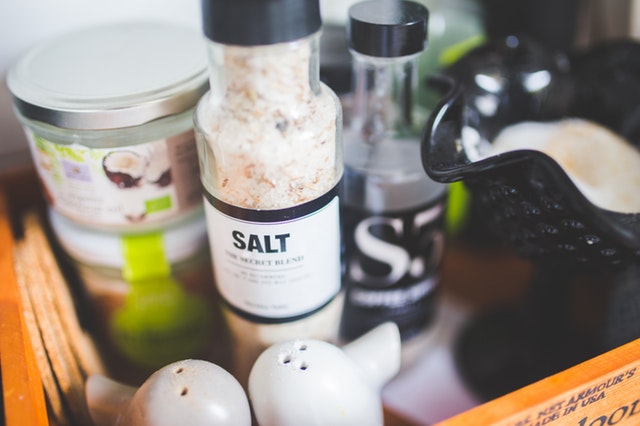Just like sugar, sodium also lurks in many foods. I looked at a wide variety of products in multiple supermarkets so I could give you the lowdown. It was an eye-opening experience for me and I think you’ll be just as shocked!
Here are my findings, along with some helpful tips:
- Deli meat and processed meats: one slice of deli meat can contain 300 mg of sodium and a single hot dog has around 700 mg sodium and this is before the bun, condiments and side dishes! Instead, opt for fresh meats.
- Boxed or canned soups: 1 serving has, on average, about 550-650 mg of sodium. Most cans contain two servings so if you eat the entire can, it would double the sodium! Look for boxes or cans to be labeled “no salt added” or “low sodium”. These options are few and far between, so I suggest making your own soup using low sodium chicken or vegetable broth and fresh ingredients.
- Vegetable juice: if you’re getting some veggies, it must be healthy, right? Well, a single serving (1 cup) can has around 650 mg sodium so I can think of better ways to get your veggies in but if you love vegetable juice, buy the low sodium version which contains 140 mg or possibly less, depending on the brand.
- Pasta Sauce: a 1/2 cup serving typically contain 450-600 mg sodium, but keep in mind that 1/2 cup is a small amount so many people may wind up using much more. I combed through a lot of different brands and found two in the 150-210 mg range. You can also buy no salt added diced or plum tomatoes and make your own sauce. Herbs and spices (garlic, basil, oregano) add a nice intensity to the flavor and if you prefer a thicker sauce, just cook it longer.
- Bread (includes rolls, bagels, pita bread, tortillas, etc.): one slice of bread can have 200 mg of sodium, therefore the outer makings of a sandwich would be 400 mg of sodium before anything else gets added. One small tortilla can have 330 mg of sodium. I recently weighed the roll in a sandwich I purchased in a gourmet deli and it was 5 ounces (which is equivalent to five servings of bread) so that alone may have around 1000 mg sodium. For starters, have them cut the sandwich in thirds and eat the other portions another time or just have the whole sandwich as a once-in-a-while treat!
- Condiments: condiments pack so much sodium into small amounts and that quickly adds up. Serving sizes range from 1-2 Tbsp depending on the condiment. For example, BBQ sauce generally ranges from 240-330 mg of sodium per serving (2 Tbsp) and soy sauce has close to 980 mg of sodium per serving (1 Tbsp). Even the “lite” soy sauce is still very high in sodium, ranging from 650-700 mg for 1 Tbsp. This is a tough one to work around, but you can try cutting down the amount you use or possibly try creating a healthier recipe. Try my low sodium BBQ sauce – you’ll never go back to bottled!
- Flavor packet foods (e.g., mac-n-cheese, taco kits, etc.): these come loaded with sodium. One prepared taco ranges from 620-790 mg of sodium so if you eat 3 tacos you may be hitting your daily limit!
- Pancakes (& other mixes): a single serving can be 800 mg of sodium. That’s over a third of your daily requirement.
- Frozen meals: people love the convenience factor of a meal being ready in 3-5 minutes, but with these quick (small-portioned) meals usually comes tons of sodium, possibly exceeding 1,800 mg.
- Salty snacks: 1 ounce of many of our favorites (cheese doodles and pretzels) fall into the 250-365 mg of sodium range. Potato chips and salted cashew nuts are on the lower end comparatively, ~160 mg sodium and ~120 mg sodium respectively, but make sure you stick with a single portion.
- Restaurant food: along with processed foods, this is the #1 source of sodium in our diets. Ideally, we’d prepare most of our meals at home, but we all know this is not realistic. Peruse the menu online ahead of time to seek out the best options. You can also try talking to the chef, you may be surprised to find that many times he/she will try and accommodate your dietary requests.
Important points to remember and other things to think about:
- Become familiar with nutrition labels.
- Watch portion size.
- Play around with non-salted seasonings like herbs and spices
- In addition to food labels, also check medicine labels as some medicines (headache, heartburn meds) contain sodium
- Learn other names for sodium that could be found on food labels. There are many, but typically it will contain the word sodium in it.
- Always seek the help of a Registered Dietitian Nutritionist to help you with your individual needs.
- Note that positive changes and initiatives are being made, including chain restaurants being required to disclose nutrient contents.
Are you shocked? It’s definitely not easy to slash the sodium, but with some mindfulness and some savvy swaps, it can be done. Every little bit helps. Check out my recipe for low sodium barbecue sauce.
Additional References:
http://www.heart.org/idc/groups/heart-public/@wcm/@hcm/documents/downloadable/ucm_300625.pdf
https://www.fda.gov/Food/ResourcesForYou/Consumers/ucm315393.htm
https://health.clevelandclinic.org/2016/06/know-salt-hiding-food/
Wendy Kaplan, MS, RDN, CSO, CDCES, CDN is a registered nutritionist specializing in oncology and weight management in Long Island and in the New York City area. Connect with Wendy on Facebook, Instagram and Twitter and read more of her blog posts and download recipes at Food4HealthRD.comof her blog posts and download recipes at Food4HealthRD.com


0 Comments